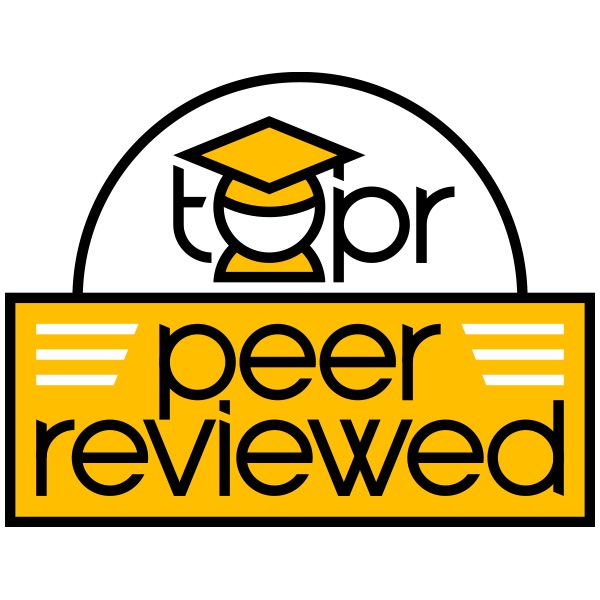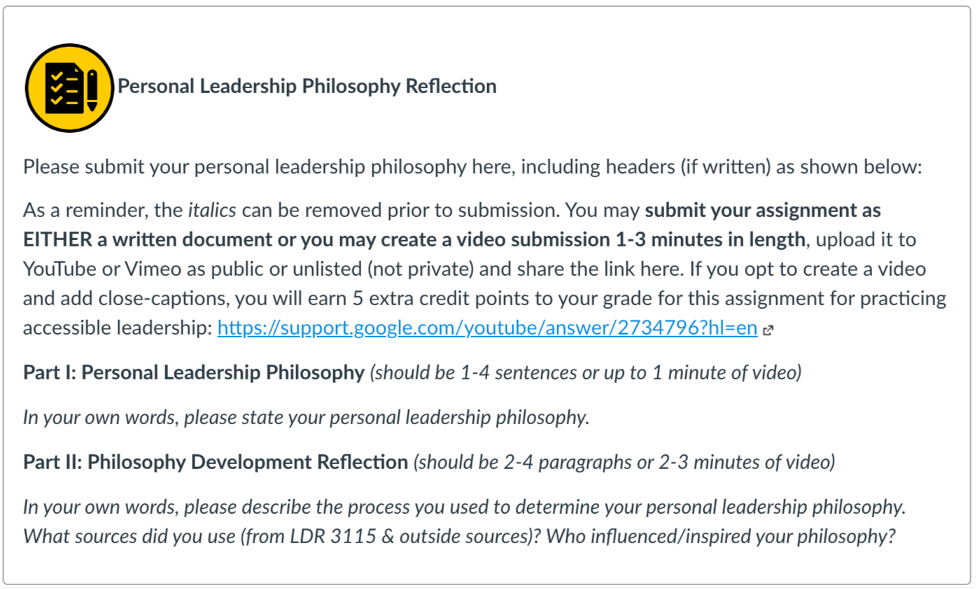
One of the tenets of Universal Design for Learning (UDL) is that of Multiple Means of Action and Expression. Far too often, faculty in higher education enact principles of UDL for the singular purpose of accessibility for learners with disabilities rather than looking at it as a framework of inclusivity for all. It is integral faculty shift mindsets to one of inclusivity when it comes to persons with disabilities and unique learning needs, “Teachers need a mindset that shapes how they approach all students in the classroom” (Eadens and Eadens 2016, p. 253).
Brabazon (2015) suggests that instead of taking a reactionary approach to inclusive instructional design, that instead, “We need to think about learners rather than impairments” (p. 78). UDL is pivotal in this paradigm shift. The Higher Education Opportunity Act of 2008 defines UDL as “A scientifically valid framework for guiding educational practice”; as such, UDL.
(a) Provides flexibility in the ways information is presented, in the ways students respond or demonstrate knowledge and skills, and in the ways students are engaged
(b) Reduces barriers in instruction, provides appropriate accommodations, supports, and challenges, and maintains high achievement expectations for all students, including [SWD] and students who are limited English proficient. (Higher Education Opportunity Act of 2008, Section 10 [https://www.govinfo.gov/link/plaw/110/public/315]; cited in Eadens and Eadens 2016a, p. 250)”
Intentionally designing classrooms centers around creating “learning environments that apply UDL principles provide[s] the necessary supports and instructional design considerations that eliminate barriers to learning” (Eadens, Eadens, Lanterman, 2021, p.17).
The three principles in the UDL framework are (1) multiple means of engagement; (2) multiple means of representation; and (3) multiple means of action and expression. Multiple means of engagement focuses on recruiting student interest, supporting persistence in the learning process, and facilitating self-regulated learning. Multiple means of representation assure that all learners are able to access content and materials, understand language and symbols unique to that content, and make sense of the content in meaningful ways. Finally, multiple means of action and expression gives learners with options for engaging with the process of learning, demonstrating and understanding using tools and media, and developing and achieving personal learning goals (Meyer et al. 2014). It is in this multiple means of action and expression that aligns most strongly with one of the intents of the UDL approach, which is “to create expert learners who are purposeful and motivated, knowledgeable and resourceful, and strategic and goal-directed…” (Eadens, Eadens, & Lanterman, 2021, p.17). One guideline within the area of multiple means of action and expression is that of providing options for expression and communication. CAST (2018) explains, “It is important to provide alternative modalities for expression, both to the level the playing field among learners and to allow the learner to appropriately (or easily) express knowledge, ideas and concepts in the learning environment.”
In higher education online classes, something as simple as allowing students in a reflective discussion or assignment to submit either a written response, audio recording, or video submission yields higher learner engagement and reduced anxiety for students who may struggle with or have a preference for a modality. If the faculty’s objective for the reflective discussion response is to see how students apply leadership principles from the course readings to creating a leadership philosophy for themselves, the faculty member does not have to do that in a traditional written discussion format. Faculty must simply ensure alignment between the learning outcomes and assessment options. Simply said, if a rubric is used, faculty must ensure that assessment matches the learning outcomes and is not dependent on modality, which ties into the UDL checkpoint 4.1, “Vary the methods for response and navigation” (CAST, 2018). Implementation of options for expression and communication in larger classes can be more challenging when there is a heavy need for assessments that are automatically graded or options where they may be only one correct answer, such as in a mathematics assessment where students solve an equation with only one solution. At UCF, there are many opportunities to utilize tools in the field of Personalized Adaptive Learning (PAL) to address some of these purposes, such as Mastery Learning Paths in Webcourses, Obojobo Next, Materia, commercial PAL providers, and others, but there must be support for the time-consuming development of these innovative tools. Personalized learning offers many opportunities to continue to expand options for expression and communication, including checkpoints 4.2: “Optimize access to tools and assistive technologies,” and checkpoint 5.3: “Build fluencies with graduated levels of support for practice and performance.” Implementation of multiple means of assessment with fidelity using these tools is a topic that would warrants further research.
Differentiated assessment options will look different in every university classroom as the menu of options (so to speak) for assessment must be based on what is already known about students’ learning preferences, abilities, and data on the class’ prior knowledge. The variability in differentiation will be dependent on the course content, concepts for testing, students’ abilities, data on student performance, and often the demands of the subject or course. The use of UDL in a classroom does not stop after delivery of instruction but can improve motivation and engagement for students as they feel that they have more control and say in the assessment of their learning. In practice, students selecting non-written options often put immense effort into the projects they create and go beyond expectations in the exploration of the topic assessed.
An example of implementation of this strategy could include introducing the module learning objective and allowing students creativity in their choice of how they demonstrate mastery of that objective. For example, in a Principles of Genetics biology class the objective of a module might be to: identify the parts, dimensions, and structure of DNA molecules, RNA molecules, and chromosomes. In assessing mastery of this concept, the instructor might opt to allow students to determine how they will demonstrate this knowledge and offer a rubric that assesses mastery of the objective without limits on the modality of demonstration. The instructor must also allot adequate time for students to devote to the exercise. Some students might opt to take an interactive quiz, others might create a model, while some might want to submit a video explaining the concept. Offering other ways to interact with the material, such as through interactive virtual exercises around the structure of DNA and RNA, would also support the principle of Multiple Means of Action and Expression as it targets many of the checkpoints within this category, including 5.2: “Using multiple tools for construction and composition” to 6.2: “Support planning and strategy development.” Vitally, students who spend time engaging in the material at multiple levels and have higher levels of engagement as they demonstrate mastery will improve retention and their ability to apply the material in and out of the course.
Link to example artifact(s)
Implementation in Dr. Danielle M. Pratt’s LDR 3115 Course:
As mentioned earlier, the strategy of multiple means of assessment is implemented in an assignment within a leadership course where students must craft their own leadership philosophies. Prior to this assessment, students spend several weeks studying several leadership principles and learning from contemporary leaders in various fields. This includes an exercise where they explore the leadership philosophies of leaders they admire. For the assignment that includes the screenshot below, the objective is for students to integrate the lessons learned and construct a personal leadership philosophy. It does not assess writing quality, simply the quality of communication. Students have the option to submit their philosophy in written or video format.

Several assignments offer similar options for various modalities of submission and the final project for the course allows students much more latitude in the format of their submission of a service-learning project. In practice for the assignment described above and other assessments offered where there are options for expression and communication format, students who may not excel in written formatted statements like this submit a video that would rival a TED talk introduction. For so many students with barriers to learning, it offers a way to assess the content without penalizing students who may communicate more effectively in different formats. It highlights each student unique talents and often leads to a deeper understanding of a student’s approach to leadership.
Link to scholarly reference(s)
Brabazon, T. (2015). Intervention Through Teacher Education. In Enabling University (pp. 77–95). Springer, Cham.
CAST (2018). Universal Design for Learning Guidelines version 2.2. Retrieved from http://udlguidelines.cast.org
Eadens, D. M., & Eadens, D. W. (2016). (Dis)ability in the elementary school classroom: Embracing an inclusive mindset. In R. Papa, D. M. Eadens, & D. W. Eadens (Eds.), Social justice instruction: Empowerment on the chalkboard. Springer. https://link.springer.com/chapter/10.1007/978-3-319-12349-3_22 .
Eadens, D.W., Eadens, D.M., & Lanterman, C.S. (2021). Disabling Injustice in the Higher Education Classroom in Mullen, C. (Ed.) in Handbook of Social Justice Interventions in Education. Springer International.
Meyer, A., Rose, D. H., & Gordon, D. T. (2014). Universal design for learning: Theory and practice. CAST Professional Publishing.
Citation
Pratt, D.M. & Eadens, D.W. (2021). Offering assessment options: motivating learners through multiple means of action & expression. In A. deNoyelles, A. Albrecht, S. Bauer, & S. Wyatt (Eds.), Teaching Online Pedagogical Repository. Orlando, FL: University of Central Florida Center for Distributed Learning. https://topr.online.ucf.edu/offering-assessment-options-motivating-learners-through-multiple-means-of-action-expression/.